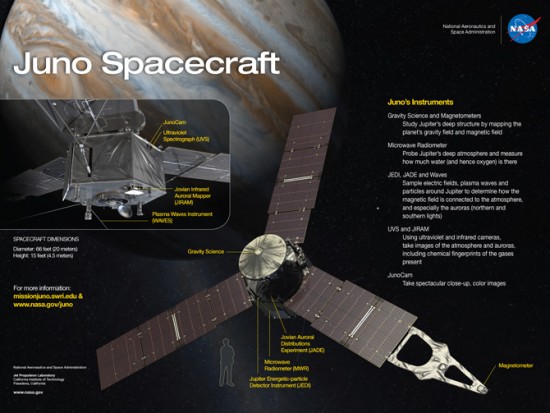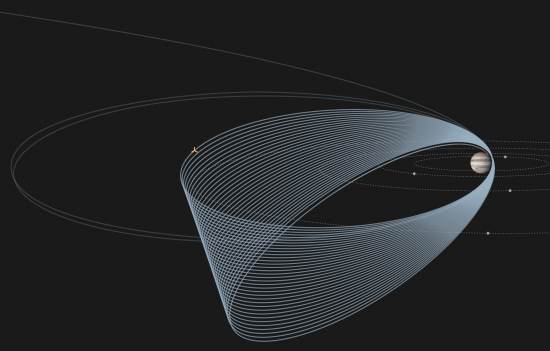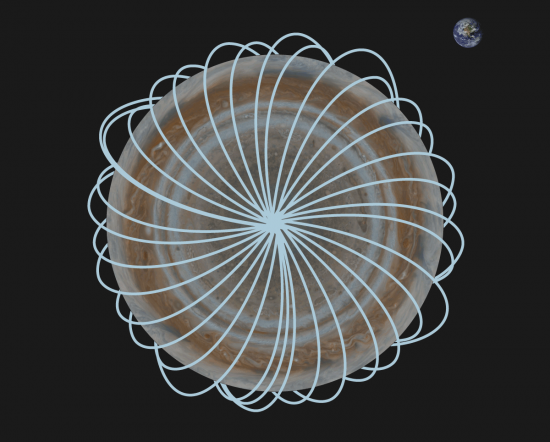July 5, 2016 – It was close to midnight on July 4th when the spacecraft Juno traveling at a speed of 265,000 kilometers (165,000 miles) per hour completed an engine burn that slowed it down by 56,000 kilometers (35,000 miles) per hour to allow it to be captured by Jupiter’s gravity. A voyage of five years had reached its destination. As the spacecraft decelerated it made its first pass through Jupiter’s intense magnetic field and came out of it with no harm done. Mission scientists were thrilled to have Juno pass this first test.
Now the real mission begins as the spacecraft begins circling the planet for 37 orbits (see illustration below) before crashing into Jupiter’s atmosphere in 2018. Each of the first two orbits will take two months. then Juno will settle into a series of much tighter elliptical orbits of approximately 14 days. The last orbit will graze the very top of Jupiter’s thick atmosphere causing the spacecraft to disintegrate. The mission scientists don’t want the spacecraft to remain circling Jupiter indefinitely out of fear that it could encounter a Jovian satellite and crash there. The big concern is Europa where a liquid ocean lies beneath the surface. So better Juno vanish and die beneath Jupiter’s clouds then potentially contaminate a place where there may be alien life.
The orbits are polar (see image below) so they will minimally intersect with Jupiter’s magnetic field, 20,000 times more powerful than Earth’s Van Allen Belts. Even so on board instrumentation will be exposed to radiation unlike any previous spacecraft has encountered. To combat this, therefore, the electronics are encased in a titanium vault.
What type of instruments does Juno carry?
- A colour camera called JunoCam to give the public spectacular close up images of Jupiter as never seen before.
- A gravity/radio science system (Gravity Science) to study Jupiter’s gravity field.
- A six-wavelength microwave radiometer for atmospheric sounding and composition (MWR) to probe Jupiter’s atmosphere and look for water and oxygen.
- A vector magnetometer (MAG) to study Jupiter’s magnetic field.
- Plasma and energetic particle detectors and a radio wave experiment (JADE, JEDI and Wave) to study how the magnetic field is connected to the atmosphere and to analyze the auroras that appear at both poles.
- An ultraviolet and an infrared imager/spectrometer (UVS and JIRAM) to take images of the atmosphere and auroras.
Juno gets power from its enormous solar panels that span 20 meters (66 feet) and are designed to capture energy from the light of a Sun five times more distant than here on Earth. Throughout the mission the spacecraft will remain in sunlight continuously so the likelihood of the instrumentation losing power is zero. But for redundancy the scientists have designed the package to require full power only 6 hours during each orbit of the planet.
When will we see the first close ups of Jupiter? On August 27 when the spacecraft completes its first orbit. It should make a close pass over the north pole allowing us to see Jupiter’s amazing clouds and its version of the Northern Lights. A second burn planned for October 19 will regularize Juno’s orbit to 14-days. And that’s when the real science will begin.


















